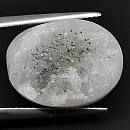|
|
|
|
 |
| Tsumoite |
|
|
Discovered in 1972; IMA status: Valid (IMA approved 1978) | |||
|
|
|
Chemistry |
|
|
| |
|
BiTe | |
|
|
Bismuth Telluride |
|
Molecular Weight: |
336.58 gm |
|
Composition: |
Bismuth |
62.09 % |
Bi |
|
|
|
Tellurium |
37.91 % |
Te |
|
| |
|
|
|
100.00 % |
|
|
|
|
|
|
||||
|
Classification |
|
|
| |
|
Sulphides | |
|
2/D.10-40 | |
|
|
2 : SULFIDES and SULFOSALTS (sulfides, selenides,
tellurides; arsenides, antimonides, bismuthides; sulfarsenites,
sulfantimonites, sulfbismuthites, etc.) |
|
Related to: |
Ingodite Group (Strunz). Tsumoite Group (Dana). |
|
Members of Group (Strunz): |
Ingodite Group: Ingodite, Kawazulite, Skippenite, Sulphotsumoite, Telluronevskite, Tetradymite, Tsumoite, Vihorlatite Sulphotsumoite, Nevskite, Ingodite, Telluronevskite |
|
Members of Group (Dana): |
Ingodite, Nevskite, Sulphotsumoite, Telluronevskite, Vihorlatite |
|
Varieties: |
None |
|
Synonyms: |
ICSD 30525, IMA1974-010a, PDF 44-667 |
|
|
|
|
Crystal Data |
|
|
|
|
|
As hexagonal plates, commonly rounded, to 5 mm, in irregular aggregates. |
|
|
None |
|
|
|
|
|
Physical Properties |
|
|
|
|
|
Perfect on {0001} |
|
|
n/a |
|
|
Brittle |
|
|
2.5 - 3.0; Vickers: VHN100=51-90 kg/mm2 |
|
|
8.16 (g/cm3) |
|
|
None |
|
|
Not Radioactive |
|
|
|
|
|
Optical Properties |
|
|
|
|
|
Silver-white; in polished section, white with a creamy tint |
|
|
Opaque |
|
|
Metallic |
|
|
R1–R2: (400) 61.0–62.2, (420) 61.1–62.3, (440) 61.2–62.4, (460) 61.3–62.7, (480) 61.4–63.1, (500) 61.5–63.4, (520) 61.6–63.8, (540) 61.7–64.2, (560) 61.9–64.6, (580) 62.2–65.0, (600) 62.5–65.4, (620) 62.7–65.7, (640) 63.0–65.9, (660) 63.1–66.0, (680) 63.2–66.1, (700) 63.3–66.2 |
|
|
0.000 (opaque) |
|
|
None |
|
|
Very weak |
|
|
Moderate |
|
|
|
|
|
Occurances |
|
|
|
|
|
Geological Setting: |
In massive Ni–Cu–PGE deposits; in Cu–Zn–Pb deposits, with sulfosalts, formed at lower temperatures. |
|
Common Associations: |
Pentlandite, Chalcopyrite, Pyrrhotite, Sperrylite, Parkerite, Maucherite, Michenerite, Tetradymite, Pilsenite, Cosalite, Altaite, Bismuthinite, Galena. |
|
Common Impurities: |
Pb |
|
Type Locality: |
Tsumo mine, Masuda, Shimane Prefecture, Chugoku Region, Honshu Island, Japan |
|
Year Discovered: |
1972 (IMA approved 1978) |
|
View mineral photos: | |
|
|
|
|
More Information |
|
|
|
|
|
| |
|
|
|
|
Tsumoite is named after its discovery locality, the Tsumo Mine, Shimane Prefecture, Japan. The Tsumo Mine is located about 50 km northwest of Hiroshima City. The area comprises Paleozoic sedimentary rocks, their metamorphic equivalents, and acidic igneous rocks of late Cretaceous age. Although Tsumoite was discovered in 1972, it was not published until an article by Hidehiko Shimazaki and Tohru Ozawa in the 1978, volume 63, issue of American Mineralogist (1162–1165). The IMA also approved Tsumoite as a new mineral species in 1978. Tsumoite
distribution: from Japan, in the Tsumo mine,
about 50 km northwest of Hiroshima City, Shimane Prefecture
[Type Locality]. At the Dashuigou Tellurium deposit,
Sichuan Province, China. In the Ban Phuc deposit, northwestern
Vietnam. From the Kolar Gold Fields, Karnataka, India.
In Russia, at the Tyrnyauz W–Mo deposit, left bank of
the Baksan River Valley, northern Caucasus Mountains;
in the Alekseevskoye mine, Sutam district, Stanovoi
Range, southeast Sakha. From the Ransko massif, about
18 km east-northeast of Havličkův Brod, Czech Republic.
At Úhorná, Slovakia. From the Bjorkdal
gold mine, Vasterbotten, and at Tunaberg, Sweden. From
Sylvanite, Hidalgo County, New Mexico, USA. In the Copper
Cliff South mine, Sudbury, Ontario, Canada. A few additional
poorly located localities are known. |
|
|
We
have not photographed our Tsumoite
gems yet. Please
check back soon. |